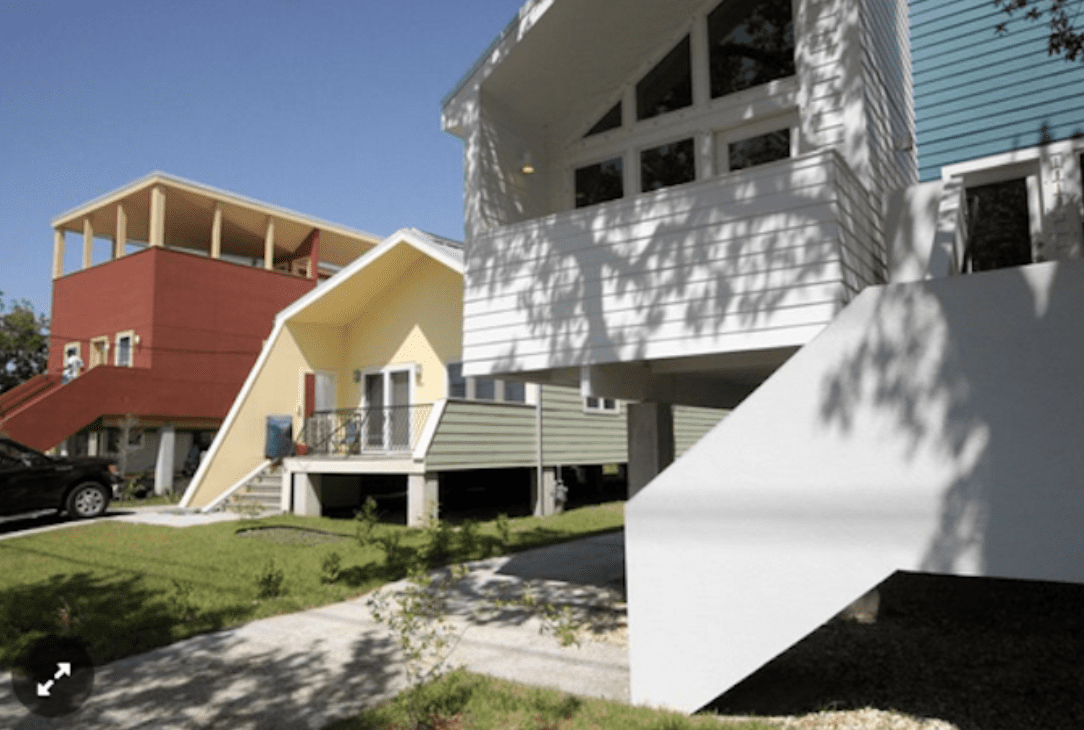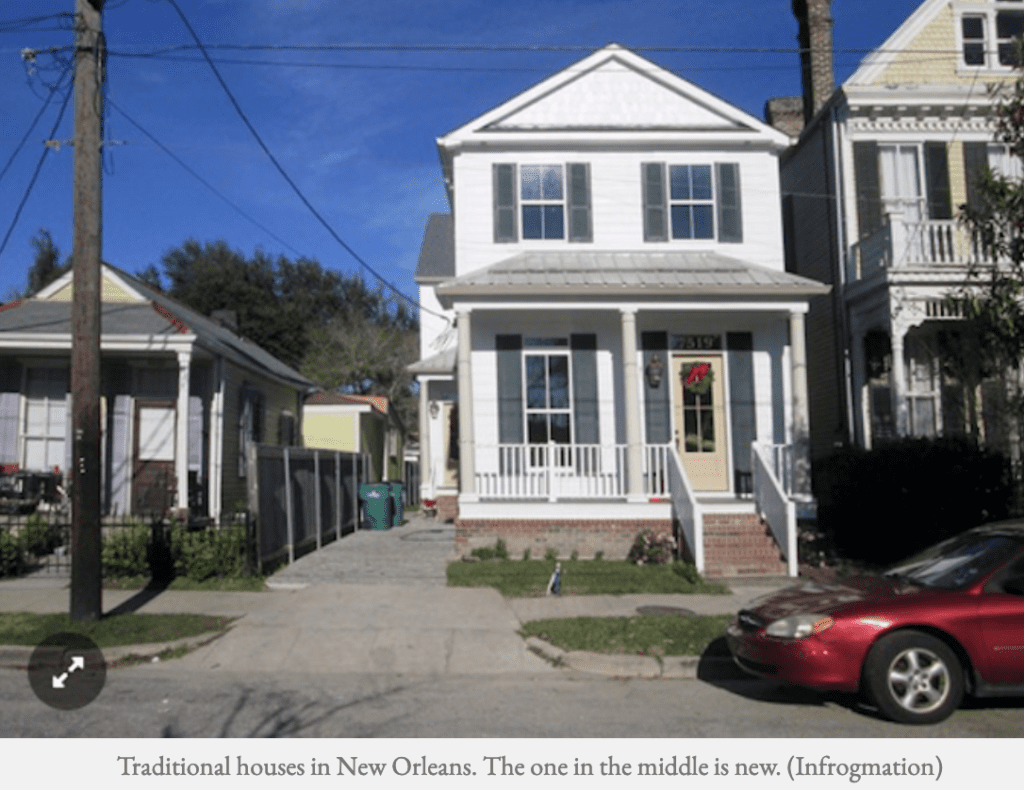Search Posts
Recent Posts
- Rhode Island Weather for May 22, 2025 – Jack Donnelly May 22, 2025
- We Cook! Mill’s Tavern Louisiana style beer braised Short Rib, Grits, Baked Beans, Cornbread May 22, 2025
- RI Veterans: Did you know? 22.05.25 (Medical, Memorial Day, War Dog, events) – John A. Cianci May 22, 2025
- RI Trucking Association calling on Governor and General Assembly to halt truck tolls May 22, 2025
- 8th annual Rhode Island Slow Pitch Softball Hall of Fame: Class of 2025 May 22, 2025
Categories
Subscribe!
Thanks for subscribing! Please check your email for further instructions.

Brad Pitt breaks rules of architecture, leaving broken homes and promises, for Katrina families – David Brussat
by David Brussat, Architecture Here and There, contributing writer
Photo, above: Experimental houses built by Brad Pitt’s Make It Right foundation
Apparently, some media outlets have discovered the joy of dishing on celebrities who think they know best. Isn’t that all of them? At any rate, the Daily Kos and the (U.K.) Guardian both have new hit pieces out on Hollywood film crush Brad Pitt, who in the wake of Hurricane Katrina rushed to New Orleans to build new modernist houses for victims in the city’s hard-hit Lower Ninth Ward.
Anyone could have predicted that the houses would suck. The Guardian’s writer, Wilfred Chan, says they suffer from “water intrusion, black mold, porches rotted through, stair rails collapsing, fires caused by electrical problems, plumbing problems and poor ventilation.” Rebekah Sager, writing for The Daily Kos, accuses Pitt of “breaking a promise” to the ward’s mostly black community.
But he did not break a promise. Pitt formed a foundation called Make It Right to build 150 affordable, ecologically sustainable houses. Bill Clinton, Snoop Dogg and others held fundraisers. Pitt and his wife at the time, Angelina Jolie, raised millions, and donated $5 million of their own money; 109 houses were built and sold to star-struck residents for $150,000.
In 2010, Pitt declared, “We’re cracking the code on affordable green homes.” By 2014 it became evident that the houses were falling apart from the inside, but in 2016 Pitt divorced Jolie, they sold their mansion in New Orleans and the Make It Right website vanished. Two years later, a study showed that only six houses of the Make It Right neighborhood remained in “reasonably good shape.” Several have already been demolished.
Class-action suits started appearing in 2018. As described in the Guardian:
Some houses had flat roofs and lacked basic features like rain gutters, overhangs, covered beams, or waterproof paint to weather New Orleans’ torrential downpours. Within weeks, houses began to develop mold, leaks and rot. Pitt’s non-profit initially made some minor repairs, but then began pushing residents to sign non-disclosure agreements before it would tell them what was wrong with their homes. “That’s when a lot of residents started to notice that things were very fishy.”
Both writers, and many others over the years, point to black mold and the other oopsies, but no one seems interested in why these houses – designed by A-list architects such as Frank Gehry, David Adjaye, and Shigeru Ban – developed such a long list of problems. They did not need to look hard to discover how Brad Pitt’s houses differed from pre-Katrina houses in the ward, for example the famous shotgun houses, which had lasted decades and even centuries.
How did they differ? They were modernist. Make It Right was dedicated to Making It Wrong.
The desire to experiment with form required cutting costs on materials. The foundation could not create groovy new houses with shape-bending features and then sell them for a mere $150,000. This price tag was already below cost, but how much below cost? It was never going to work.
Brad Pitt wasn’t the only one building new houses in New Orleans after Katrina. Of these, it seems only Pitt wanted to break the traditional rules of architecture. A study by Tulane identified 333 houses built between late 2005 and 2012, according to building permits, found that by a hefty 14 to 1 margin, residents wanted houses of traditional rather than modernist styles. As of 2012, Brad Pitt’s houses were only 1 percent of new houses built post-Katrina.
What may be more surprising than the failure of Make It Right is the behavior of its founder, Brad Pitt, certifiably a good guy, you’d think. When the writing on the wall resolved into Thou shalt not experiment on the poor, Pitt headed for the hills. The Hollywood hills, of course. Maybe that should not be so surprising. White privilege, anyone? It’s only when a blue-chip celebrity breaks the laws of architecture does the public notice, not to mention the authorities. Traditional architecture is not only more beautiful but more utilitarian and more sustainable than modern architecture. They used to build it right; now, they hardly ever do. Let’s hope Make It Right turns out to be an effective teaching moment.

___
To read other articles by David Brussat: https://rinewstoday.com/david-brussat-contributing-writer/

My freelance writing and editing on architecture and others addresses issues of design and culture locally and globally. I am a member of the board of the New England chapter of the Institute of Classical Architecture & Art, which bestowed an Arthur Ross Award on me in 2002. I work from Providence, R.I., where I live with my wife Victoria, my son Billy and our cat Gato. If you would like to employ my writing and editing to improve your work, please email me at my consultancy, [email protected], or call (401) 351-0457

In contrast one might take a look at the 21 homes, affordable for first time homebuyers, along DePasquale Avenue and Federal Street in Federal Hill. DESIGN AND DEVELOPMENT OF PROTOTYPE NEIGHBORHOOD RESIDENTIAL LOT FOR GOOD URBANISM
Federal Hill East Homes Redevelopment Project and Old HOMe.
The HOMe Housing System is a national award winner for sustainable and affordable home design. The urban plan and design of HOMe in the Federal Hill East Homes Redevelopment Project was the first true affordable housing project in Rhode Island. The Four Star Energy rated project was also the first to integrate new urbanism principles in the neighborhood design and site design of the 21 constructed homes on Federal Hill in Providence, RI in the early 1990’s. The original HOMe design (Papa Bear) and the OLD HOMe design of Federal Hill (Mama Bear) were both featured in two major articles in the Providence Journal. The HOME Housing System won a National Award from the U.S. Department of Housing and Urban Development, HUD, in 1980 in their “Building Value Into Housing Program” and prestigious design awards from AIA New England and AIA Rhode Island. Design variations: right/left hand plans, 8 roof lines, 21 three color paint schemes.
The City of Providence requested FILARSKI to develop a prototype lot concept and urban site design for the redevelopment of the Federal Hill East project. The area of the project development was awash with drugs and crime. FILARSKI responded to the typical 50‘ x 100’ lot parameters by setting the house close to the sidewalk, maintaining the street line, decreasing the utility run into the yard to the house, minimizing the surface area for parking, and optimizing the amount of yard space available for private use, vegetation, and tree canopies. Solar panels, lush plantings, and owners’ finishing touches abound creating an identifiable neighborhood within a neighborhood.
The Awards Jury commented:
“We wish to recognize this kind of effort as an important endeavor…and a highly significant contribution to the community. We would like to see all architects involved in the design of affordable housing and communities, and to emulate the high quality of design and thought embodied in this model housing and urban design project.”